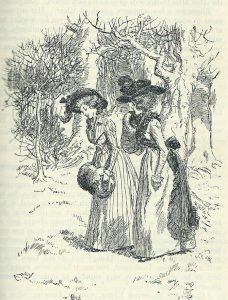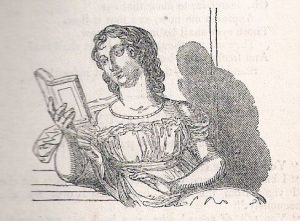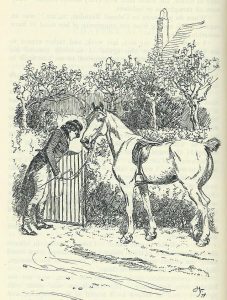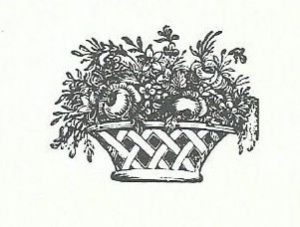In 2013, Joanna Trollope published Sense & Sensibility, one of the Austen Project books which aimed to re-write Jane Austen’s novels, scene by scene, but in a modern setting. I have only just read it, and I can’t understand how I came to miss it – perhaps because 2013 wasn’t a good year for me. I thoroughly enjoyed it, and she has an interesting take on Margaret Dashwood.

I was also interested, from a technical point of view, to see how Joanna Trollope coped with the problem that, in the Regency period, no lady ever had to earn her own living. It just wasn’t done. How could that transfer to a believable 21st century setting? Joanna Trollope does it very cleverly; Sense & Sensibility is a book about love and money, remember.
Elinor, age 19, the eldest Dashwood daughter, is in the final year of her architecture course; Marianne, 17, is about to go to the Royal College of Music, and Margaret, 13, is at her expensive day school. Mrs Dashwood, once an art teacher, is now the hippy, artistic chatelaine of Norland Park – old Uncle Henry, who first invited the Dashwoods to Norland, liked to have her around, filling the house with flowers and creating a delightfully Bohemian ambience – so she doesn’t have to worry about getting a job. It fits perfectly. Later, Elinor gets a job to help make ends meet, and Margaret goes to a state school where, of course, she survives without too much trouble.
And the Dashwoods do have some capital: £200,000, the equivalent to the £10,000 that the 19th century Dashwoods had. It brings them in £10,000 a year, which may sound a lot of money but it cannot support four women in much more than the basics, once rent, council tax, water rates, utility bills etc. have been paid.

Most of the men in the book are rich – like Sir John Middleton, Mrs Dashwood’s cousin who offers her and her daughters a cottage on his estate at a low rent. He’s made his money in Country Clothing, a business he rescued from the doldrums, and he’s a brilliant entrepreneur. Mrs Jennings, Sir John’s mother-in-law, is a rich widow with two daughters, Mary Middleton and Charlotte Palmer, both of whom have married very well. They are still at the having babies stage so they don’t have to go out to work. The same goes for the ghastly Fanny Dashwood (née Ferrars), whose husband, John, is half-brother to the Dashwood girls. Fanny also comes from a very wealthy family, and is determined to add Norland Park to her portfolio, and turn the house into an upmarket B & B.
Lucy Steele, who has Edward Ferrars, Fanny’s brother, in her sights (he is due to inherit a fortune, providing he does what his appalling mother tells him), relies on being invited for long visits by her richer cousins, Mrs Jennings and Lady Middleton. Lucy is very good at flattery and manages to wangle an invitation to stay with Fanny Dashwood, where she becomes a favoured guest.
Somehow, Joanna Trollope makes all this believable – we’re not talking Hello style in your face rich here – the world Joanna Trollope has created for her Sense & Sensibility is more solid upper middle-class; uninterested in gold taps or posh villas in the Bahamas but seriously wealthy, nonetheless.

Lucy Steele confides her secret to an unwilling Elinor
But what of Margaret? The moment I started reading Joanna Trollope’s Sense & Sensibility, I realized that she must be an Emma Thompson fan. Emma Thompson invented the tree house for her screenplay; first at Norland Park where she notes in her diaries, ‘Margaret’s tree-house is palatial. Not quite what I had in mind,’ And Margaret gets another tree house at Barton Cottage. Jane Austen’s Sense & Sensibility has no mention of a tree-house.
Joanna Trollope’s Margaret also has two tree houses: one at Norland Park, and the Barton Cottage one built by Sir John’s servant, Thomas, so that she can get a signal for her mobile.
Joanna Trollope has taken Emma Thompson’s as an inspiration for her own Margaret and run with it. Both Margarets are typical teenagers. Joanna Trollope’s Margaret is particularly good at one-liner put-downs. When her half-brother John Dashwood displays all the signs of a man who always does what his wife says, Margaret says acidly, ‘She’ll be looking for you . . . Has she got a dog whistle she can blow to get you to come running?’
She also comes straight out with home truths when everyone else seems to be pussyfooting around. Take the scene where the Dashwoods are talking about Great-Uncle Henry’s will which made no proper provision for Mrs Dashwood and her three daughters. Mrs Dashwood talks about primogeniture, which ensures that property descends to the eldest son; Elinor points out that they are not the royal family – there’s no throne at stake; but Margaret says, ‘I expect that Dad couldn’t leave you anything much because he hadn’t married you, had he?’

Reading lady
Even Elinor, the straight-talking one, is thrown, ‘Just because you know something, Mags, or even think it, doesn’t mean that you have to say it.’ It’s a brilliant way of getting across the family’s financial disadvantages in a 21st century way. Without the legal protection of legitimacy, the Dashwoods can lay claim to nothing.
Marianne and Mrs Dashwood are in tears but Margaret isn’t. ‘She shrugged again, but she didn’t look tearful. She looked instead, mildly rebellious; but at thirteen, she often looked like that.’
Margaret is also a source of an amusingly rude gag. Take the famous scene in the original novel where Margaret tells Mrs Jennings, and Sir John and Lady Middleton that Elinor’s mysterious young man’s surname begins with an ‘F’, which allows Sir John some heavy-handed puns on playing music in F Major and so on.
Elinor is upset and hopes the ‘joke’ will die down; but Joanna Trollope’s Sense & Sensibility neatly turns it into an-going quip by having Sir John constantly referring to Edward as ‘the F-word boy’ which catches on. It made me laugh out loud – such a brilliant touch – and a pun that Jane Austen, once she’d had it explained, would surely have enjoyed. Her letters show that she was quite capable of being unblushingly direct when she wanted to be.

‘Lovers’ from ‘The Lady’s Pocket Magazine.’
But Margaret is more than just an awkward teenager; Joanna Trollope allows us to see her gradually growing-up. Marianne is being worryingly intense, and Margaret has been ostentatiously listening to loud music on her iPod; Elinor is just about to blow her top, when Margaret suddenly takes out her earplugs and says to Elinor, ‘Sorry.’
Elinor shot out her left hand and grasped her sister’s nearest one. ‘Megs. For what?’
Margaret sighed. ‘Just . . . being a pain.’ (Willoughby had promised her a ride in his Aston Martin. He’s just left for London without any explanation, leaving Marianne devastated.)
Margaret has reached the age where she wants to understand. She now asks Elinor, ‘Is he (Willoughby) really just a tosser?’
Elinor gave Margaret’s hand a squeeze and then let it go. ‘Well, he’s not behaving very well to Marianne.’
‘Is – Is she overdoing it a bit?’
Elinor hesitated. ‘Not according to how she sees things, Mags.’
They turned in through the gates to Barton Park’s drive, Elinor’s headlights picking up ghostly tree trunks. Margaret spun the dial on her iPod to silence it. Then she said, ‘Do we have to have boyfriends?’
‘Who?’
Us. Us girls.’
Elinor said, half-laughing, ‘Of course we don’t have to. But we seem to want to, to need to, don’t we?’
‘But we don’t need to make them our whole world, do we, like Marianne?’
‘Not,’ said Elinor carefully, ‘if it doesn’t suit us to.’

The frontispiece for ‘A Correspondence between a Mother and her Daughter’ by Ann Taylor, 1817
It’s a short scene but it shows Joanna Trollope’s mastery of getting across a lot of emotion, understanding and information in a short space. Margaret trusts Elinor and we see that she is right to do so. Furthermore, we can also follow Margaret’s gradual emotional development.
We find further evidence for this when Marianne is rushed to hospital with a serious asthma attack. Colonel Brandon offers to fetch Mrs Dashwood and sets off for Barton Cottage. Elinor rings to tell her mother and talks to Margaret. Margaret – oh, bless her, really bless her – had sounded calm and together, and reassured Elinor that they would be ready for Bill, whenever he came…
By this time. we are completely involved in Margaret’s life; we care about her. By contrast, Jane Austen’s Margaret has little three-dimensional reality. However, it’s only fair to note that Sense & Sensibility was Jane Austen’s first novel, and she didn’t made the same mistake in her later novels: Kitty Bennet in Pride & Prejudice, for example, is a minor character who is also three-dimensional.
As in the original, Margaret is on stage when, towards the end of the book, Edward reappears and they all think that he has married Lucy Steele. Jane Austen’s Margaret, ‘understanding some part, but not the whole of the case, thought it incumbent on her to be dignified, and therefore took a seat as far from him as she could, and maintained a strict silence.’

Edward returns to Barton Cottage
Joanna Trollope’s Margaret is made of sterner stuff. Edward, driving a large car, arrives at Barton Cottage in a state of extreme nervousness. A few minutes later, Margaret, returning from school with Elinor, is outraged at seeing him with what looks like an expensive new car, and says sarcastically, ‘New car? New wife?’
Eventually, all is explained; Edward and Elinor become engaged and the whole family have a celebratory supper:
Margaret felt rather proud of their happiness. They had been absolutely glowing with it at supper – Ed was like a different man . . . and Margaret had found herself wanting somehow to augment all this joy and so she said, out of the blue, ‘Why don’t you two go up to my tree house? There’s masses of space now.’
Elinor had beamed at her. ‘Oh, Mags! Could we?’
And Ed had looked as though she had given him a present or something, and had got up, and come round the table to hug her, and said, ‘You’re a complete star, Mags Dashwood. D’you know that?’
Margaret had felt not only a glow of satisfaction, but also a novel sense of having done something both good and useful.

The family pack a basket with wine, glasses, chocolate biscuits, apples and cheese, and help Ed and Elinor climb up to the tree house. Marianne puts some candles in jam jars; Mrs Dashwood gives them a blanket, and they leave them there, with each other and their future.
Margaret is now, plainly, in a different place from where she was at the beginning of the book, and the reader feels both involved with her and also satisfied by the emotional journey she’s made. Margaret is very much part of Joanna Trollope’s Sense & Sensibility; her part may be a small one but it is not unimportant.
Elizabeth Hawksley
Please share this page...
Now this is interesting. I had not taken in that you were exploring a modern version of the book. You’ve made me want to read it. I like the comparisons you’ve made here, which really do point up Austen’s very different original of Margaret. Fascinating dissection. Thank you.
Thank you for your comment, Elizabeth. I think you’d like Joanna Trollope’s ‘Sense & Sensibility.’ I think she’s a very clever and perceptive writer – and brilliant at illuminating how people interact. She can do both sexes equally well – which is rare.
I can’t say that I have ever had much interest in Jane Austen’s work, but I found these two blogs posts quite illuminating nevertheless.
Your loss, Huon. But thank you for reading my blog! Perhaps, one day, you’ll give her a whirl.
This is so interesting. Margaret Dashwood doesn’t get much of a look-in in the original (or in the movies) but Austen did make that strength of character shine through, so I’m not surprise that Trollope has formed a heroine from the outline. Lovely.
Thank you for your comment, Vonnie – and welcome to my blog. I enjoy looking at unexplored themes or not often asked about characters in Jane Austen’s novels. It can throw up some surprising answers.
Jane Austen’s miniatures are so exquisitely painted that I’ve hesitated to read any of the re-imaginings in case the authors have used too heavy a brush; but you do tempt me to try this one – thank you Elizabeth!
Thank you for your comment, Prem. I know what you mean but Joanna Trollope – and Emma Thompson, for that matter – have both expressed the greatest admiration for Jane Austen’s work and, after all, we still have Jane Austen’s books; it’s not as if they’ve been defaced or lost.
I actually found Joanna Trollope’s take on S & S very illuminating, especially with regard to Edward Ferrars who is all too easily regarded as just a wimp. Her Elinor explains exactly why Edward felt he had to behave as he does – it’s all to do with him being bullied by his mother as a child and not wanting to put Lucy through what he went through and letting her down. And it makes sense.
I find this fascinating. I confess I avoided the Austen bicentenary publishers-induced fanfic. But I can see that in Joanna Trollope’s case I made a mistake. Shall read it immediately.
I completely agree with you about Emma Thompson’s screenplay for S&S. I thought she made Edward Ferrars’s imprisonment in the role of Good Boy and Devoted Son completely believable. When he was younger, it would have taken Lucy Steele’s forwardness to get him to the point of even contemplating standing up to his Mama.
Thank you, Sophie. Edward Ferrars is such a difficult character to like and Emma Thompson’s screen play certainly helped (as did Hugh Grant!) But it wasn’t until I read Joanna Trollope’s ‘Sense & Sensibility’ that I completely understood him. I’m sure you’ll like her take on S & S. She writes with great emotional intelligence and can be very funny.
I love Margaret’s very typical teenage stroppiness, shouting: ‘Ruin my life – why don’t you?’ and stamping out of the room. I thought, ‘Yep. Been there!’